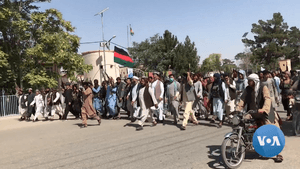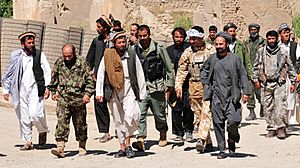Taliban facts for kids
The Taliban is a large Sunni Islamic group that acts like a militant (armed) organization in Afghanistan. This group was the government of Afghanistan from 1996 to 2001. They took control of most of Afghanistan again in August 2021. Since the capital city Kabul fell on August 15, 2021, the Taliban has been in charge of the whole country.
Contents
History of the Taliban
In 1994, the Taliban started a government in southern Afghanistan. They called it the Islamic Emirate of Afghanistan. The first leader of the Taliban was Mullah Mohammed Omar.
Taliban Rule (1996-2001)
The Taliban ruled Afghanistan between 1996 and 2001. During this time, their leaders put in place very strict rules based on Islamic law. Many important Muslim scholars did not agree with these strict rules. For example, if someone stole something, the Taliban would cut off one of their hands. Many people accused of crimes were killed in public without a fair trial. Anyone who did not follow their rules was seen as an enemy. Every man had to go to the mosque for prayer five times a day, unless they were not Muslim.
The Taliban became known for treating women very badly. They took away many human rights from women. They also treated Shia Muslims and non-Muslim minority groups (like Hindus and Sikhs) very poorly. All forms of art, music, and entertainment were banned. Sculptures, paintings, photos, cameras, and televisions were destroyed. The Taliban also destroyed the ancient Buddhas of Bamiyan in 2001. They believed showing human and animal figures was wrong.
Taliban and the United States
After the September 11 attacks in 2001, the United States invaded Afghanistan. The Taliban had been letting their friend al-Qaeda use Afghanistan as a safe place. The U.S. government said that Osama bin Laden and al-Qaeda were behind the attacks in the U.S. The Taliban asked for proof before they would arrest them. The U.S. invasion aimed to remove the Taliban from power, destroy al-Qaeda, and capture bin Laden. After losing power in 2001, the Taliban moved its main base to Pakistan.
In February 2020, the United States and the Taliban signed an agreement called the Doha Agreement. This agreement said that all U.S. troops would leave Afghanistan by May 1, 2021. President of the United States Joe Biden later said the U.S. would start leaving on May 1, 2021, and finish by September 11, 2021. This would be exactly 20 years after the September 11 attacks.
On August 15, 2021, the Taliban took control of Kabul. The Afghan government fell apart. The Taliban then controlled most of Afghanistan. By August 30, 2021, the Taliban had full control of the country. This ended the War in Afghanistan after many people were evacuated.
What the Taliban Believes
The Taliban follows certain ideas:
- Jihadism: A belief in holy struggle.
- Islamic fundamentalism: A very strict way of following Islam.
- Deobandi Islamism: A specific school of Islamic thought.
- Religious nationalism: A strong belief in their religion and country.
- Pashtunwali: Traditional rules and customs of the Pashtun people.
Taliban's Money
It is thought that in 2020, the Taliban made about $1.6 billion. A large part of this money came from illegal activities. They also made money from mining, taxes, donations (gifts), and selling goods to other countries.
Taliban's Rules for Society
The Taliban has very strict rules for how people should live. These rules are much stricter than in many other Islamic countries.
They had these rules for girls and women:
- Girls and women aged eight and older must not be near men who are not their close family or husband.
- Women must wear a burqa (a full body covering) when outside. They must also be with a male family member.
- They must not wear shoes with high heels.
- They must not speak loudly in public. This is so strangers cannot hear their voice.
- All windows on the ground floor and first floor of houses must be covered. This is so no one can see a woman inside from the street.
- Taking photos or making movies of women is not allowed. This also applies to pictures of women in magazines, books, newspapers, or shops. It even applies inside their own homes.
- Place names that included the word "woman" had to be changed. For example, a "women's garden" became a "spring garden."
- Women are not allowed to use balconies or gardens where they live.
- Women must not be on radio, TV, or in other media. They are not allowed to go to public meetings.
- Girls can go to school until they reach puberty. After that, they should get married and take care of their children.
Taliban Violence Against People
The Taliban has attacked civilians (people who are not soldiers) in Afghanistan. A report from the United Nations said that the Taliban caused over 76% of civilian deaths and injuries in 2009. In 2010, they were again responsible for more than three-quarters of civilian deaths and injuries. Civilians were attacked by the Taliban twice as often as Afghan government forces or international troops.
In 2011, the Afghan Independent Human Rights Commission said that the Taliban attacking civilians was a "war crime". Religious leaders said these attacks were wrong and against Islamic rules.
Also in 2011, groups that work for human rights asked the International Criminal Court in The Hague to investigate if the Taliban had committed war crimes.
Human Rights Problems
When the Taliban took control of Afghanistan, they promised to forgive fighters and officials from the old government. However, by the end of 2021, groups like Human Rights Watch found that the Taliban had killed many of these people without fair trials. Because of this, the United States, the European Union, and other countries told the Taliban to keep their promises.
Taliban's Connections with Other Countries
- Russia: Russia has met with the Taliban often in recent years. Russia's ambassador (Dmitrij Zjirnov) met with Taliban representatives in Afghanistan on August 18, 2021.
- United States: On August 23, 2021, the head of the CIA, William Burns, met with a Taliban leader (Abdul Ghani Baradar). This was the highest-ranking U.S. official from the Biden administration to meet with the Taliban.
- Norway: Norway has been in contact with the Taliban since 2007. For several years, Norwegian diplomats have met with the Taliban for peace talks in Doha (Qatar). As of late 2021, Norway still had diplomats at these talks.
Taliban's Connections with Other Armed Groups
Tehrik-i-Taliban
The Tehrik-i-Taliban Pakistan group works in northwestern Pakistan. It is sometimes called the Pakistani Taliban. However, it is a separate group from the Taliban in Afghanistan.
Before this group started, some of its future leaders and fighters were among 8,000 Pakistani fighters. These fighters fought in the War in Afghanistan (1996–2001) and the War in Afghanistan (2001–present). They fought against the United Islamic Front and NATO forces. Most of them came from the Pakistani side of the border with Afghanistan. After the Afghan Taliban lost power in late 2001, most Pakistani fighters, including those who would later join Tehrik-i-Taliban, went back home to Pakistan.
Peace Talks
As of late 2021, there has been little progress in the peace talks held in Doha.
Current Leader
- Hibatullah Akhundzada (since 2016)
Images for kids
-
President Ronald Reagan meeting with Afghan Mujahideen leaders in the Oval Office in 1983
See also
 In Spanish: Talibán para niños
In Spanish: Talibán para niños





